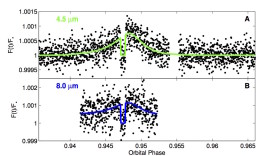Weather variations in the atmosphere of a planet on a highly eccentric orbit are naturally expected to be extreme. Now, a study has directly measured the wild changes in the atmosphere of a highly eccentric hot Jupiter as it passes close to its host star.

Diagram of the HD 80606 system. The inset images labeled A–H show the temperature distribution of the planet at different stages as it swings around its star. [de Wit et al. 2016]
Eccentric Opportunity
For a hot Jupiter — a gas giant that orbits close to its host star — the exoplanet HD 80606 b exhibits a fairly unusual path. Rather than having a circularized orbit, HD 80606 b travels on an extremely elliptic 111-day orbit, with an eccentricity of e ~ 0.93. Since the amount of flux HD 80606 b receives from its host varies by a factor of ~850 over the course of its orbit, it stands to reason that this planet must have extreme weather swings!
Now a team of scientists led by Julien de Wit (Massachusetts Institute of Technology) has reanalyzed old observations of HD 80606 and obtained new ones using the Spitzer Space Telescope. The longer observing time and new data analysis techniques allowed the team to gain new insights into how the exoplanet’s atmosphere responds to changes in the stellar flux it receives during its orbit.
Extreme Variations
By measuring the infrared light coming from HD 80606, de Wit and collaborators modeled the planet’s temperature during 80 hours of its closest approach to its host star. This period of time included the ~20 hours in which most of the planet’s temperature change is expected to occur, as it approaches to a distance a mere 6 stellar radii from its host.
The authors find that the layer of the atmosphere probed by Spitzer heats rapidly from <500K to 1400K (that’s ~440°F to a scalding 2000+°F!) as the planet approaches periastron.The atmosphere then cools similarly quickly as the planet heads away from the star once more.

Relative infrared brightness of HD 80606 b at 4.5 and 8 µm. The dip marks where the planet passes behind the star, as viewed from Earth. [de Wit et al. 2016]
Exploring an Atmospheric Layer
Based on the authors’ models, the layer of the planet’s atmosphere probed by Spitzer absorbs ~20% of the radiation incident from the host star. This atmospheric layer has a ~4-hour radiative timescale, much shorter than the ~93-hour rotation period the authors estimate for HD 80606 b — which means that the heat is not transported efficiently from the day side to the night side of the planet.
These measurements are the first of their kind for an exoplanet’s atmosphere, opening a new window into our understanding of hot Jupiters. Applying the methods used here to other eccentric planets should help us to better understand the formation mechanisms and atmospheres of these extreme planets.
Citation
Julien de Wit et al 2016 ApJ 820 L33. doi:10.3847/2041-8205/820/2/L33

1 Comment
Pingback: hot Jupiter temperature extremes